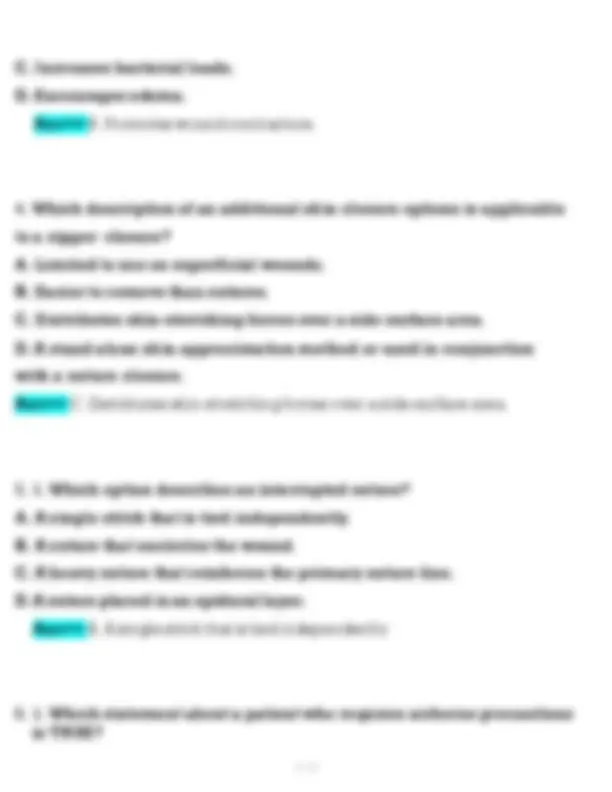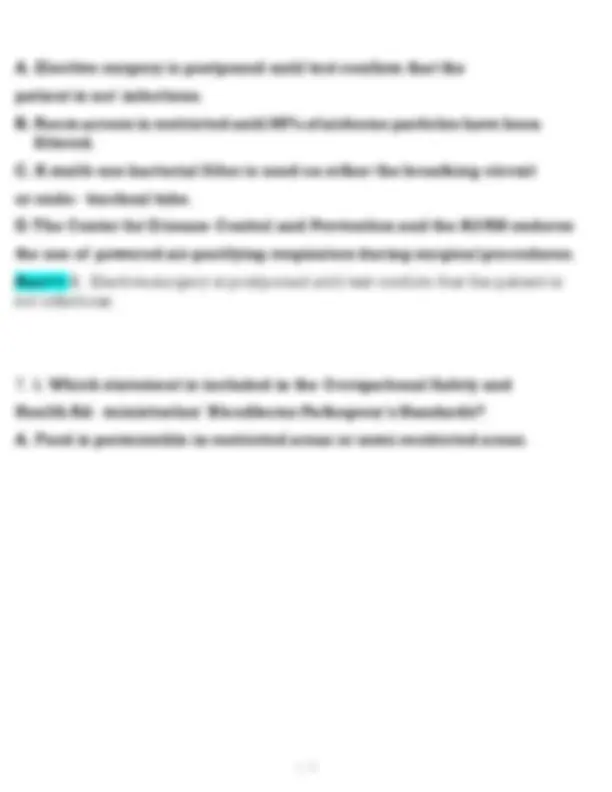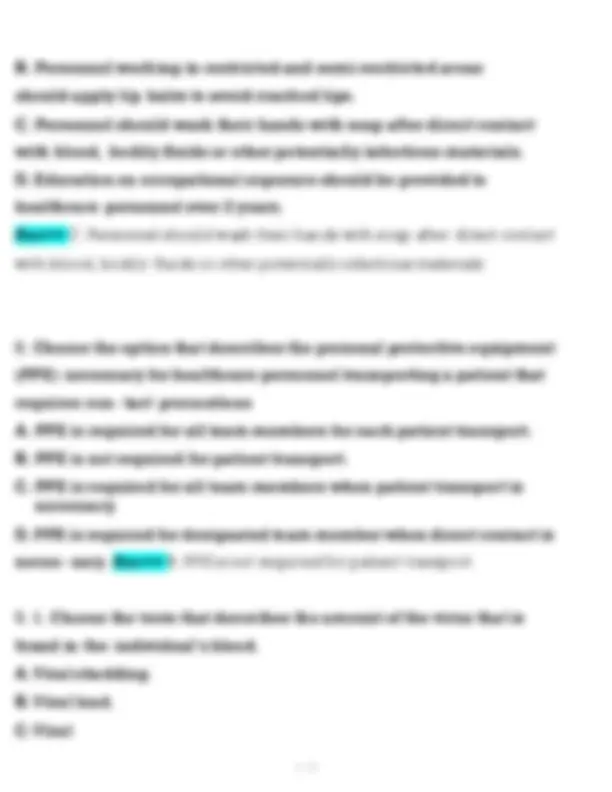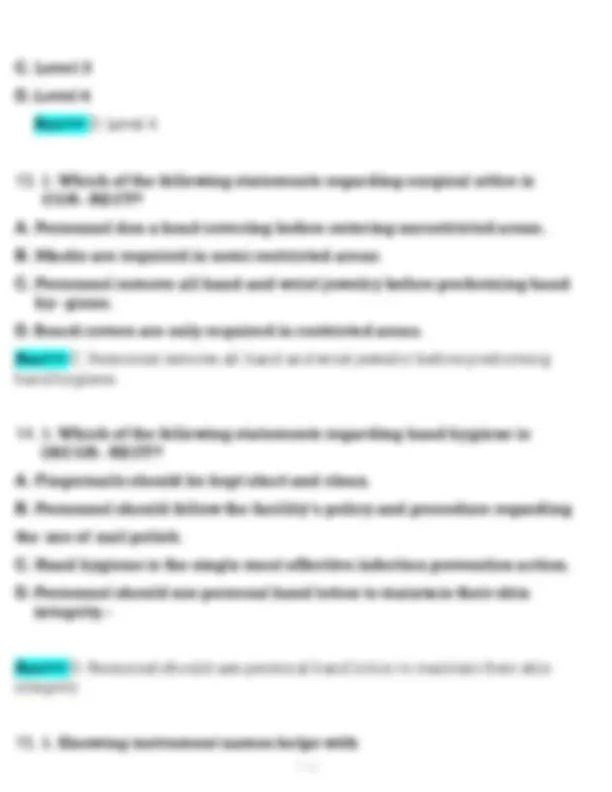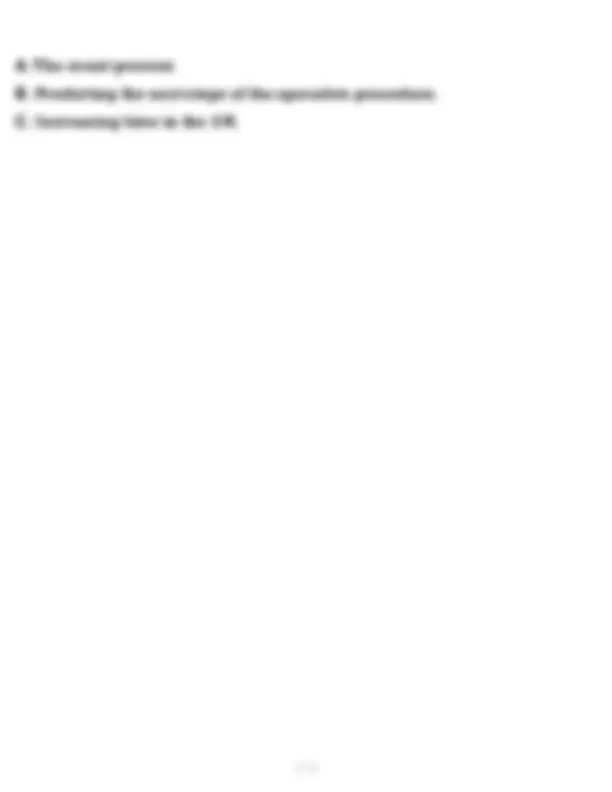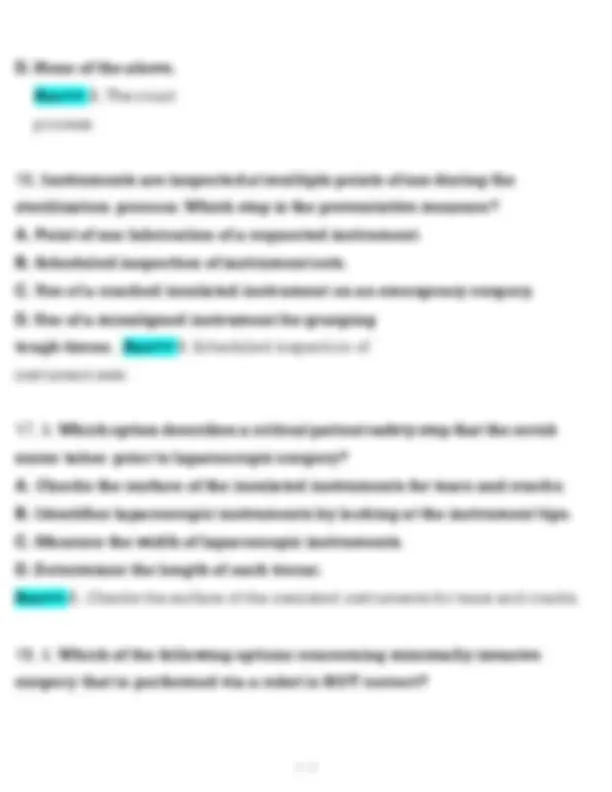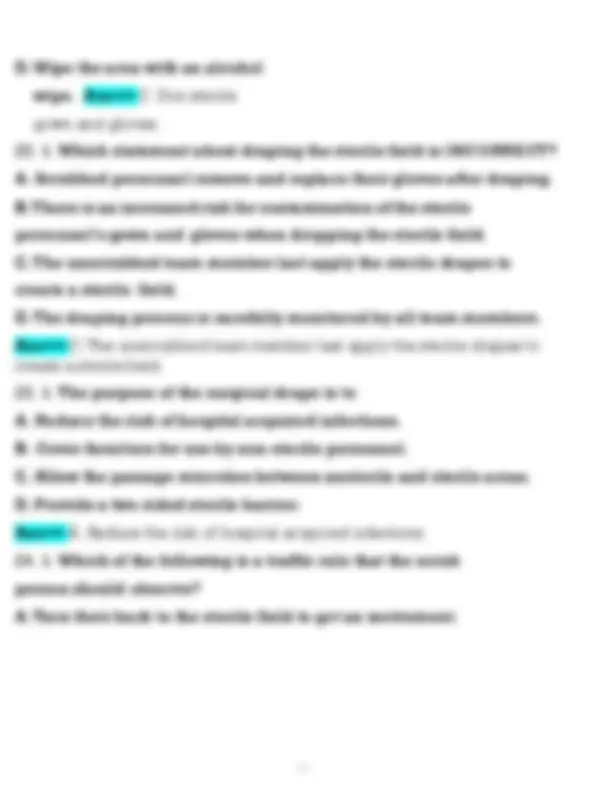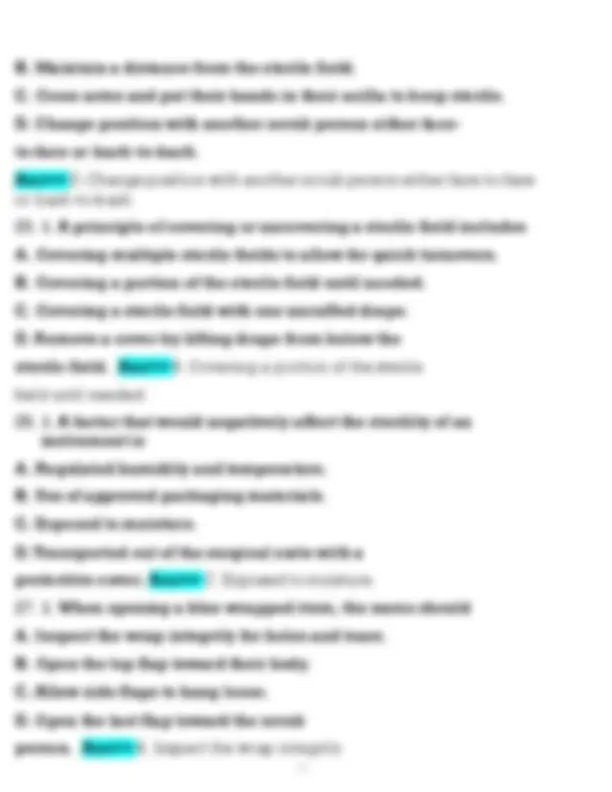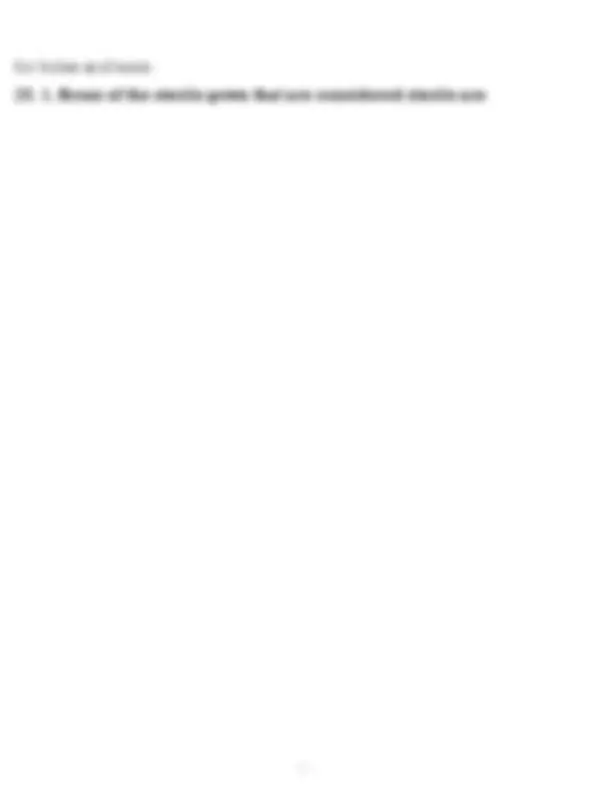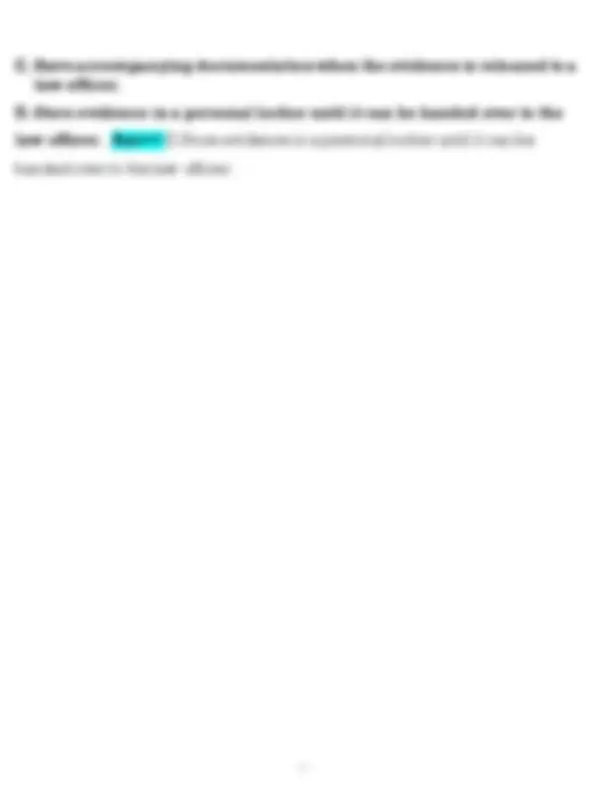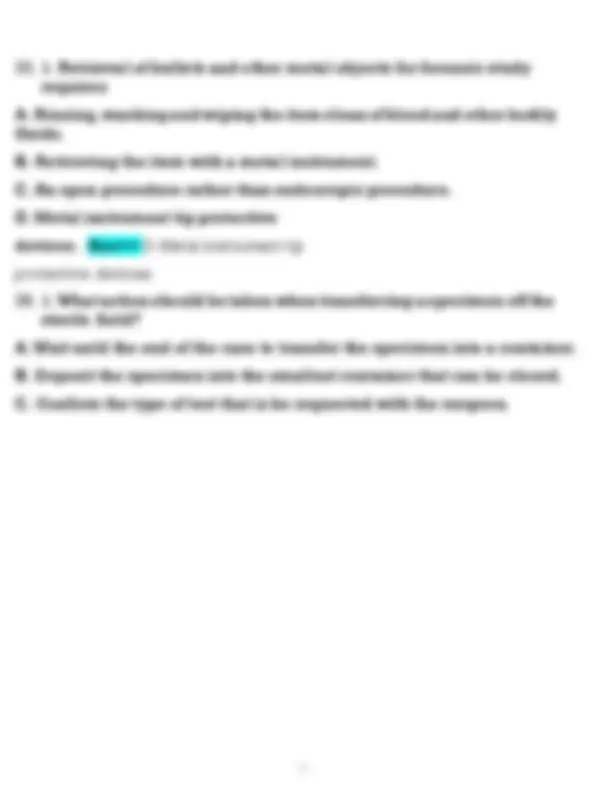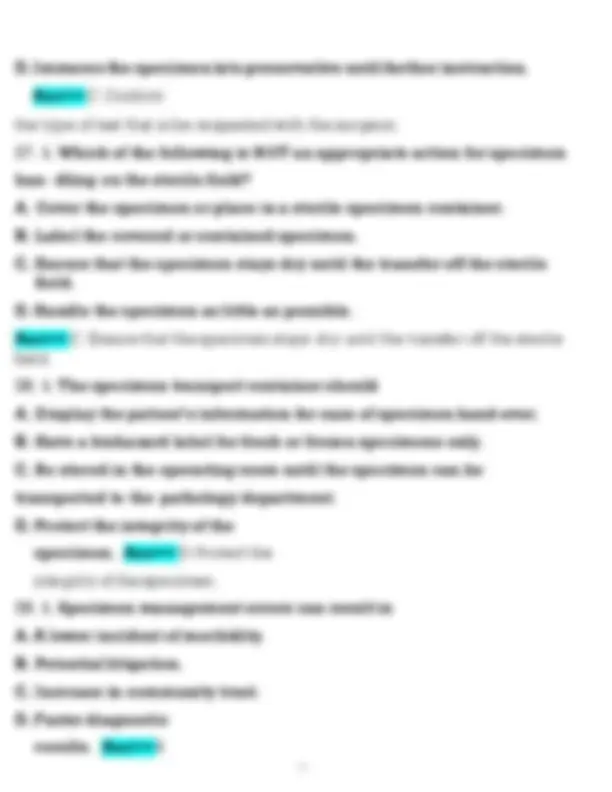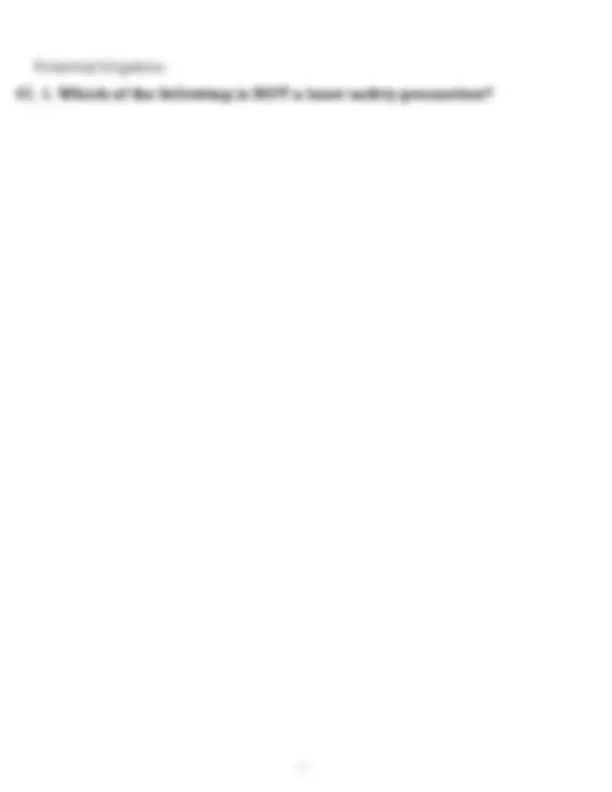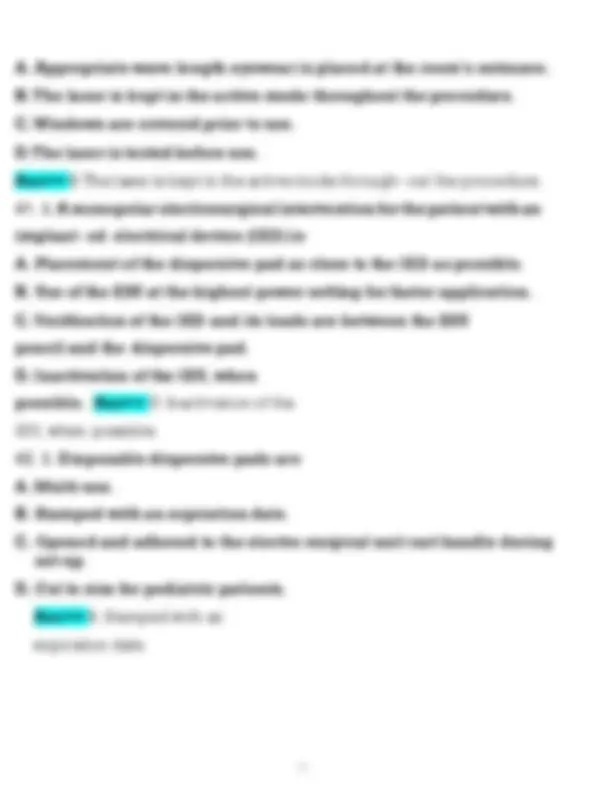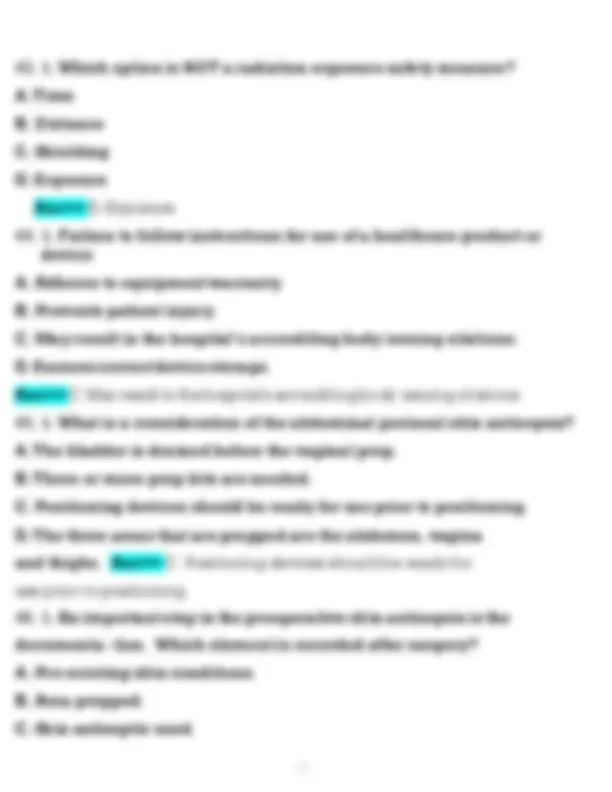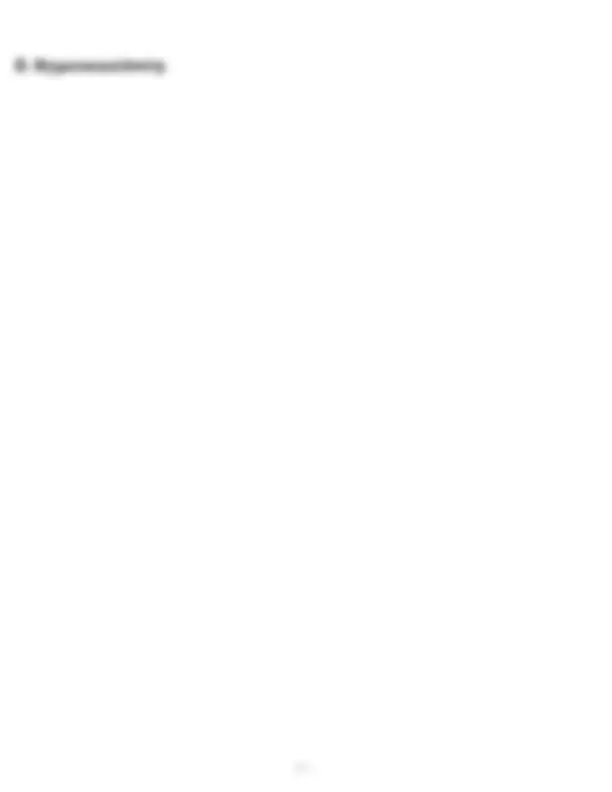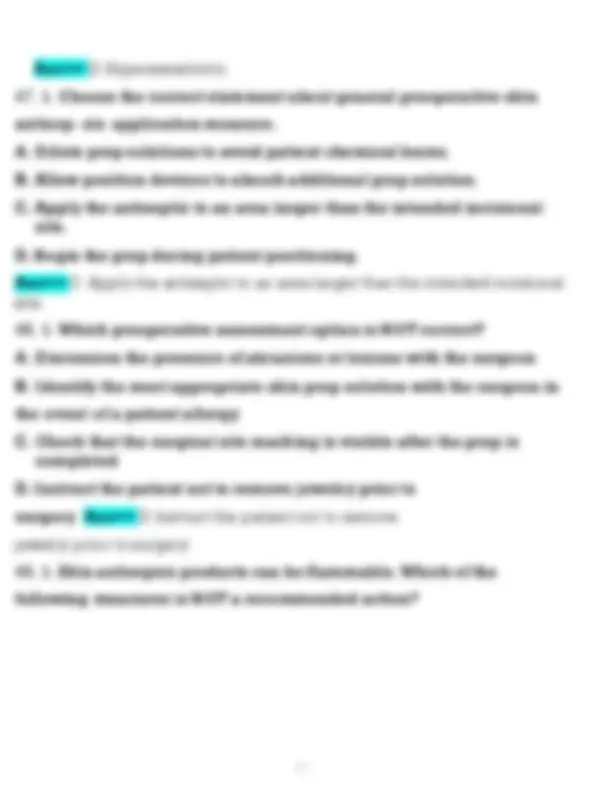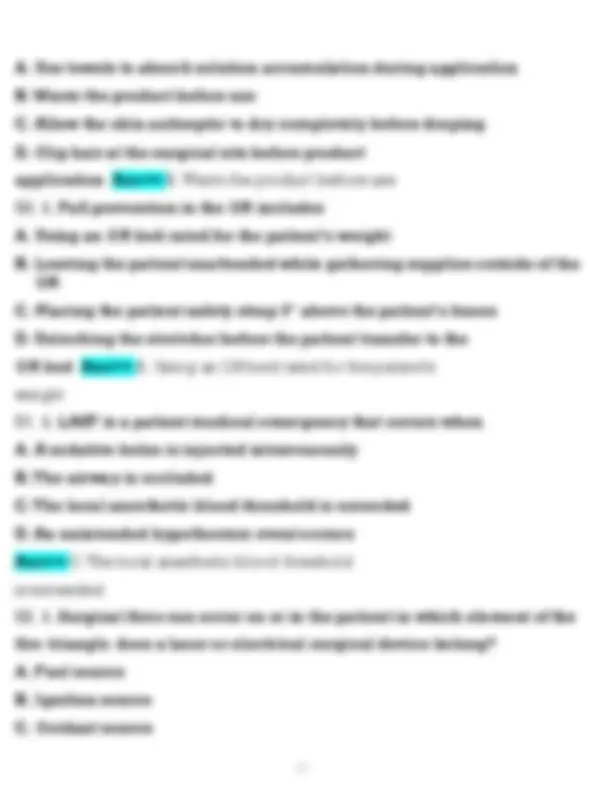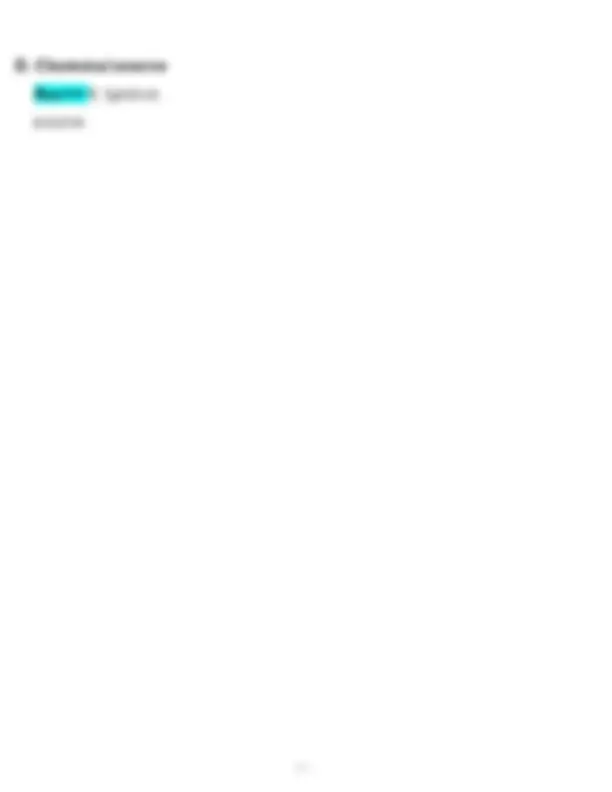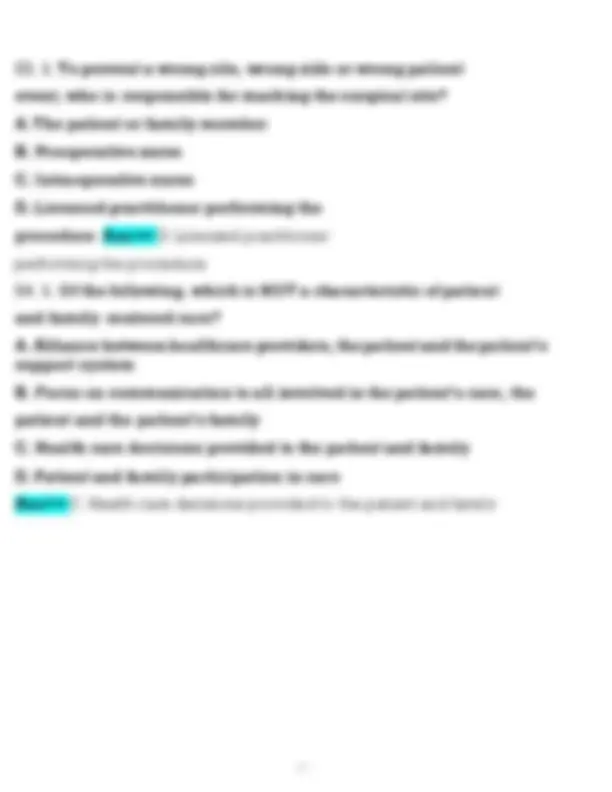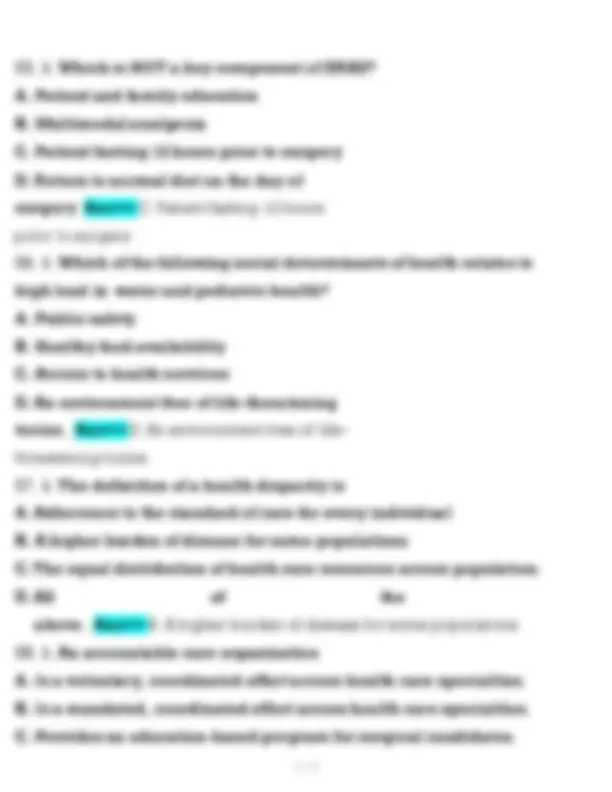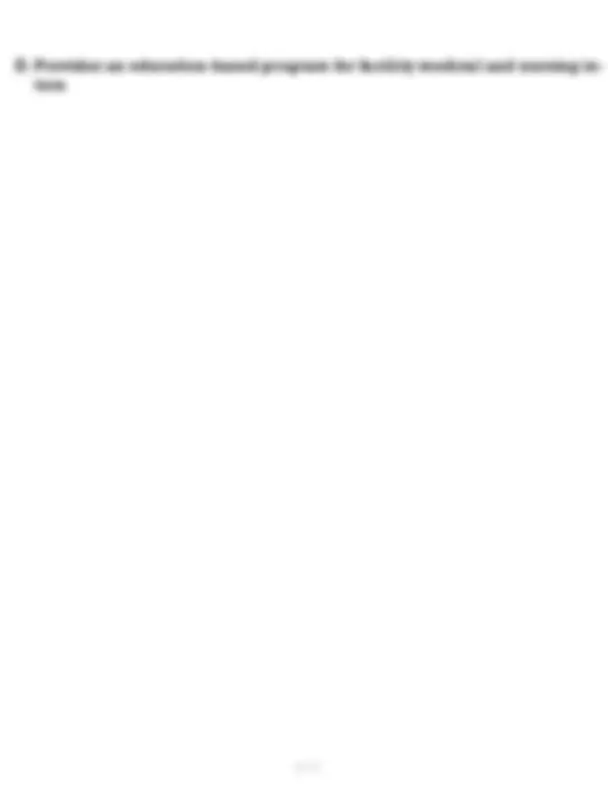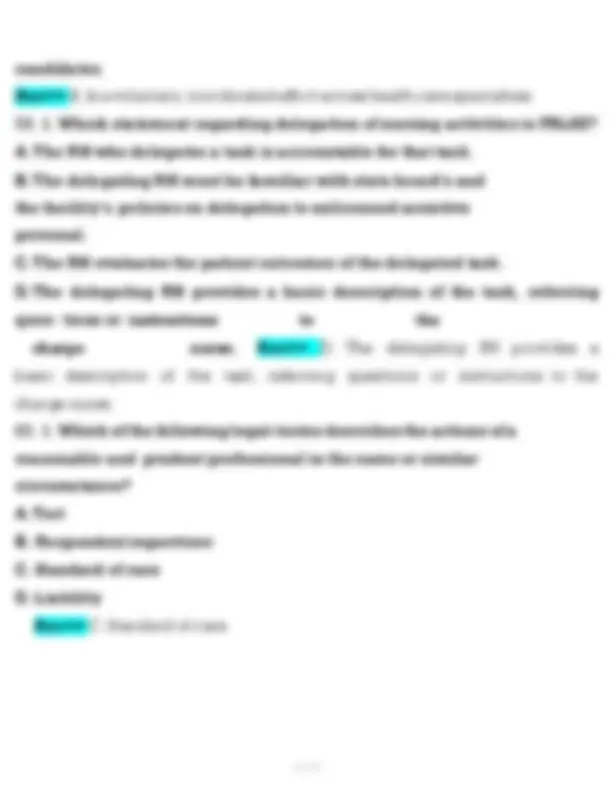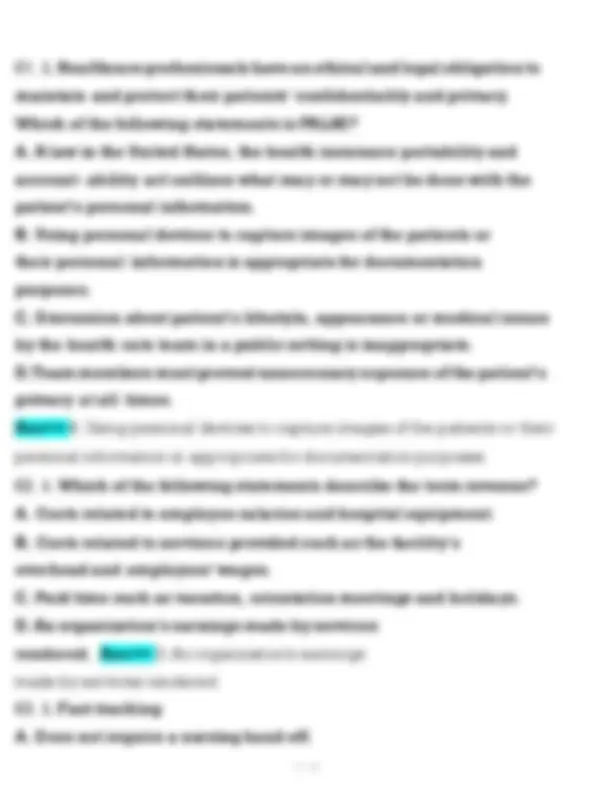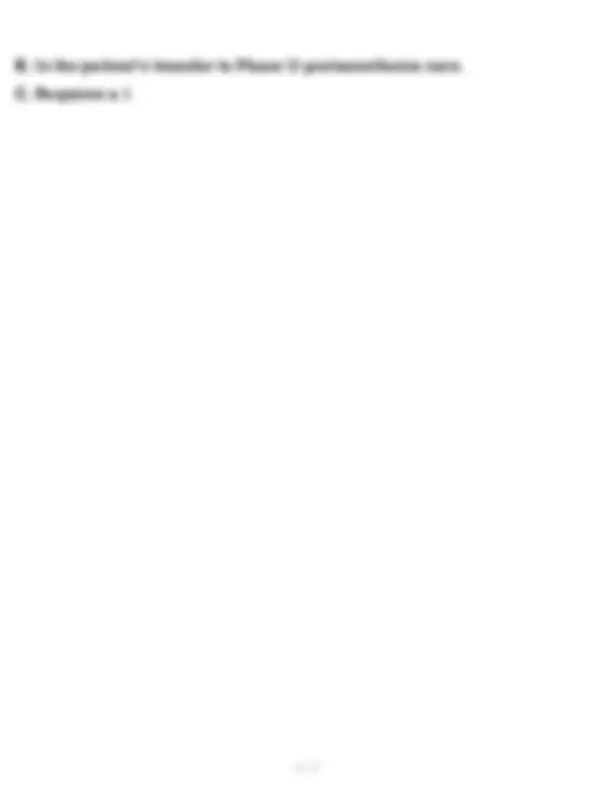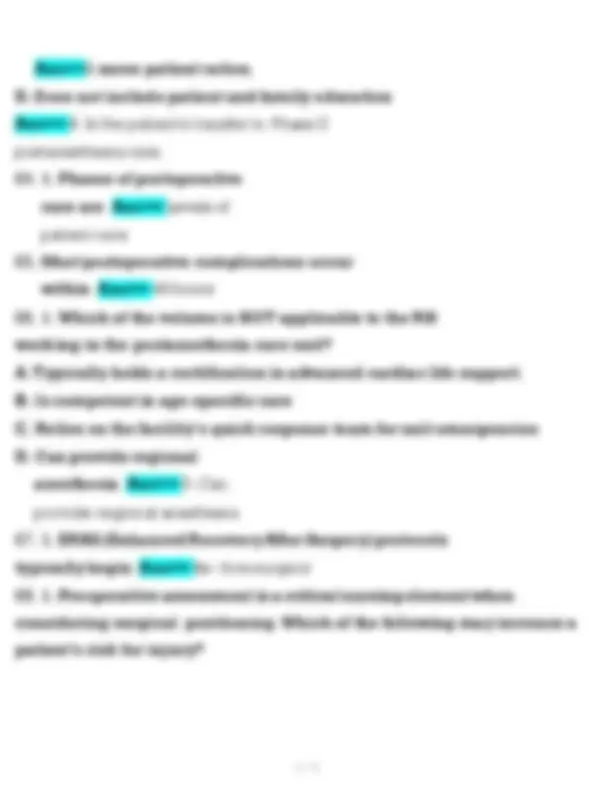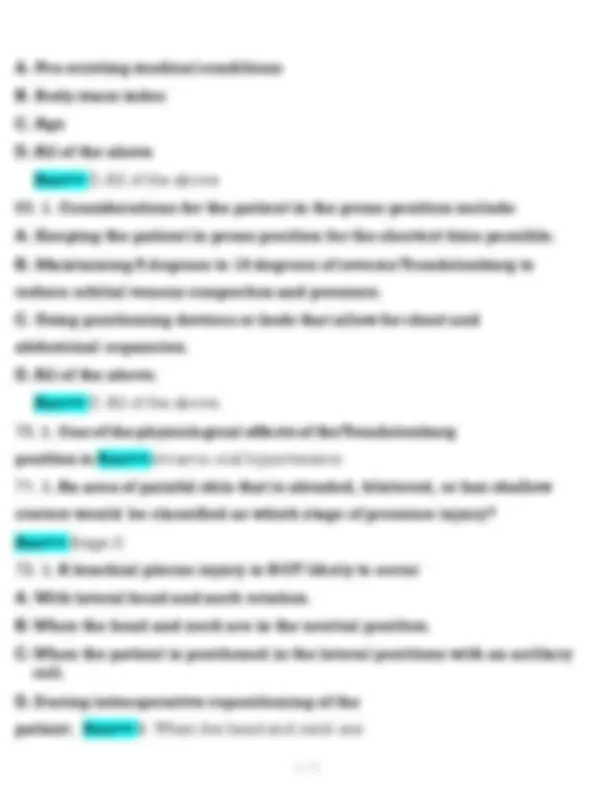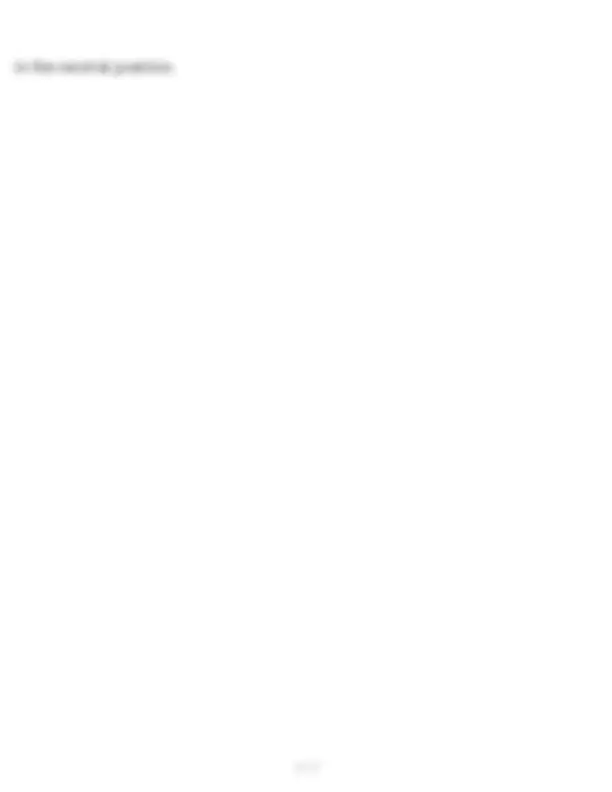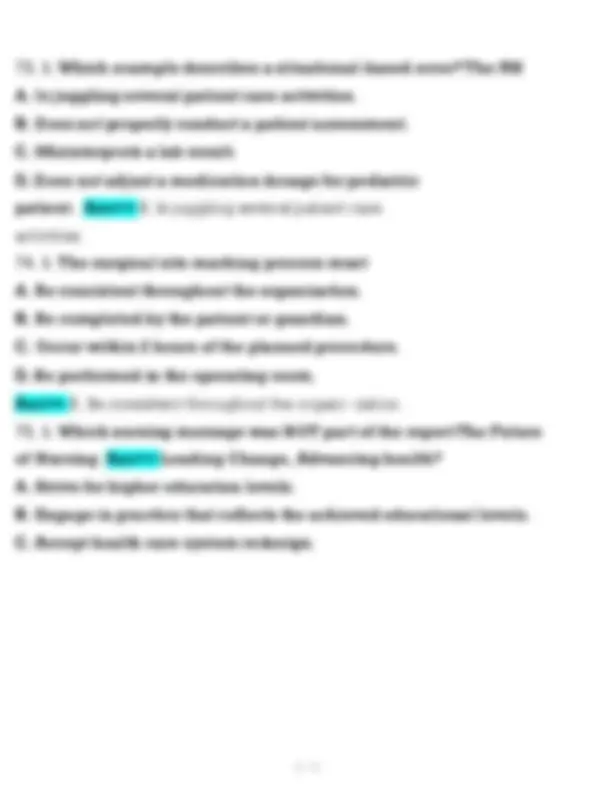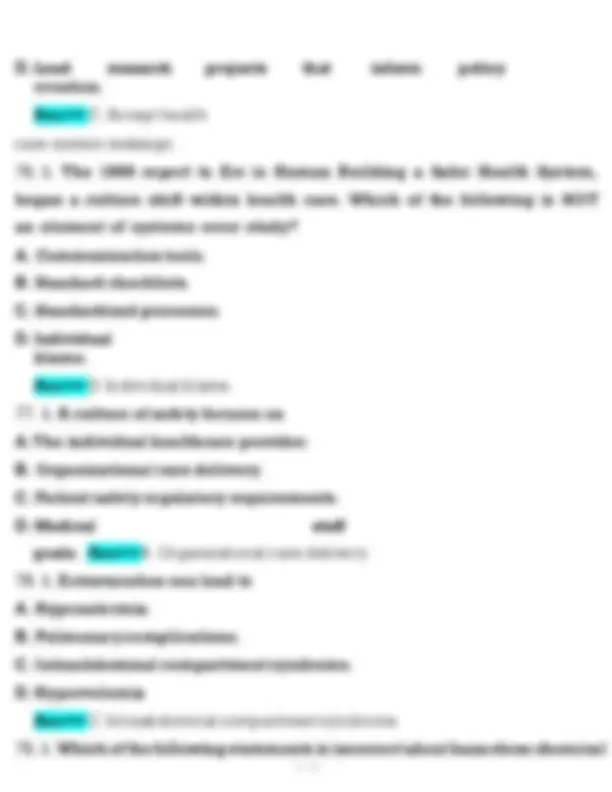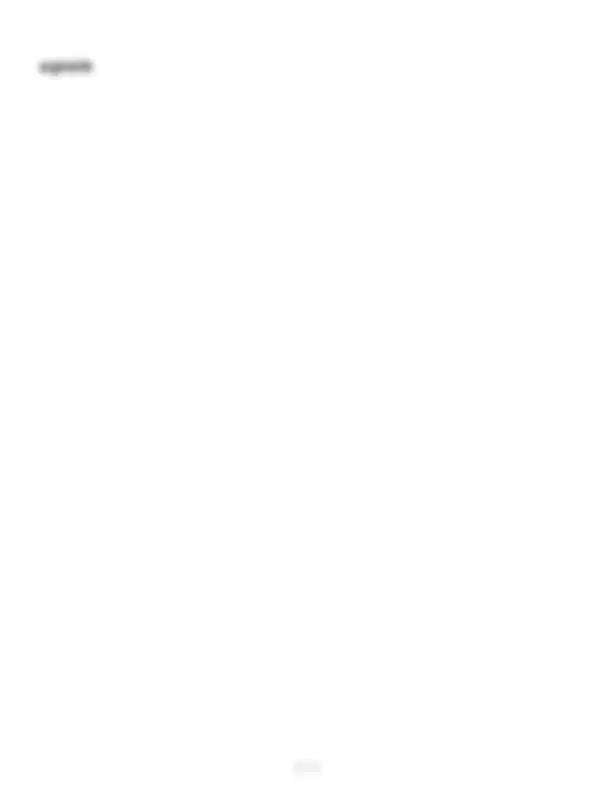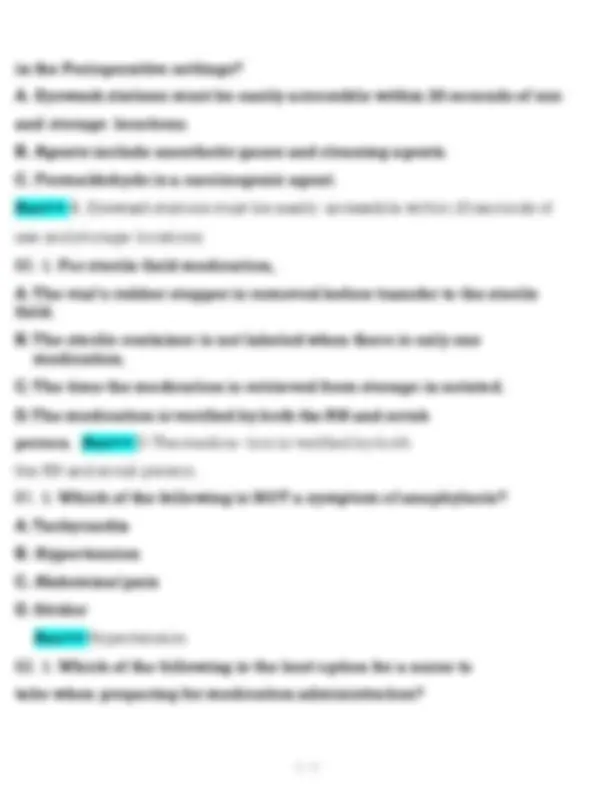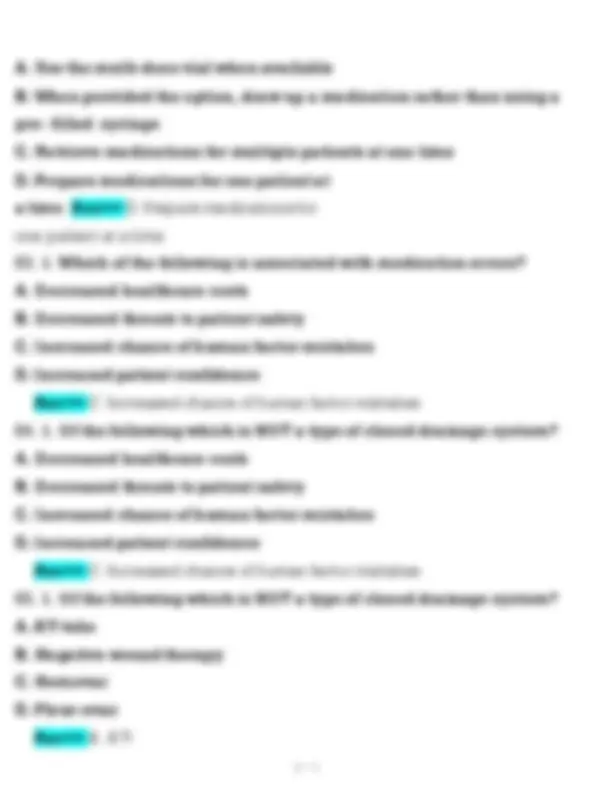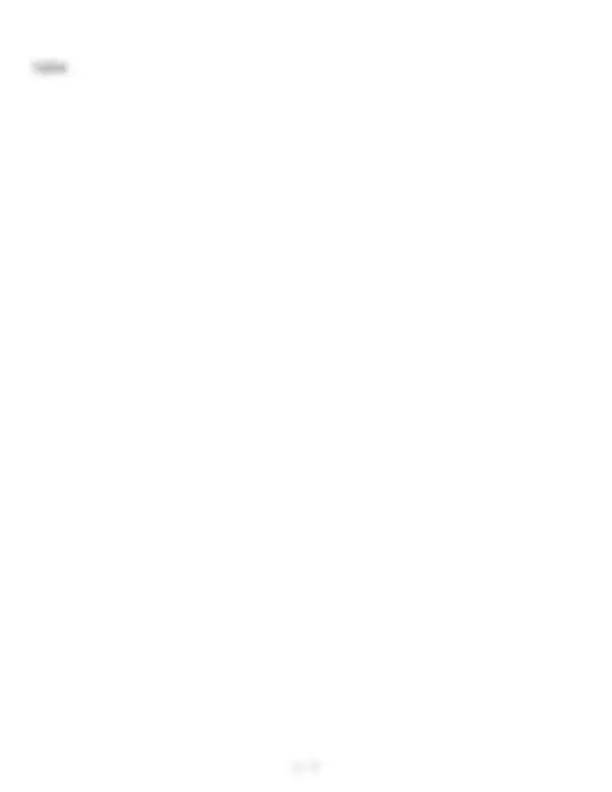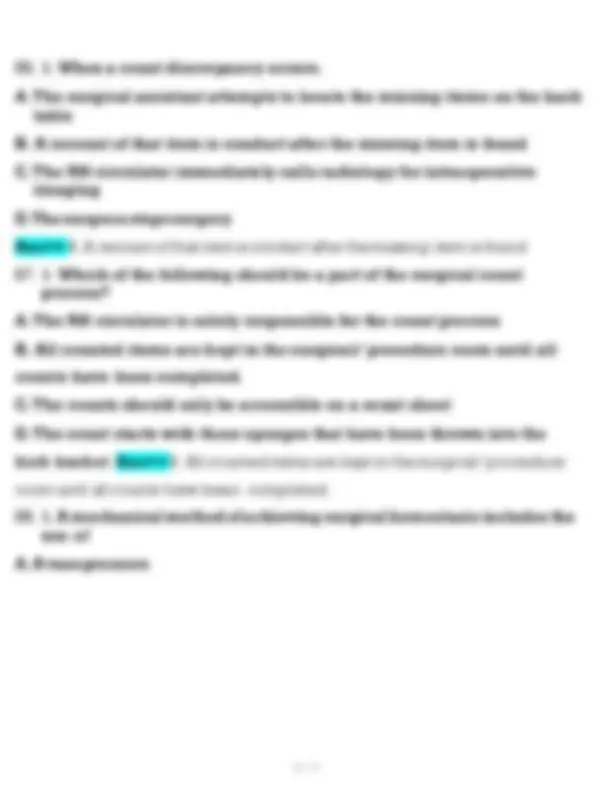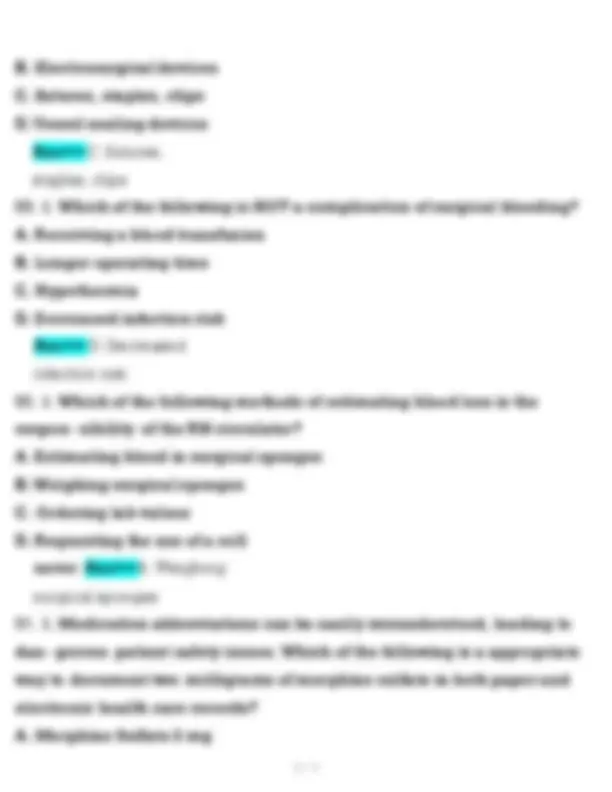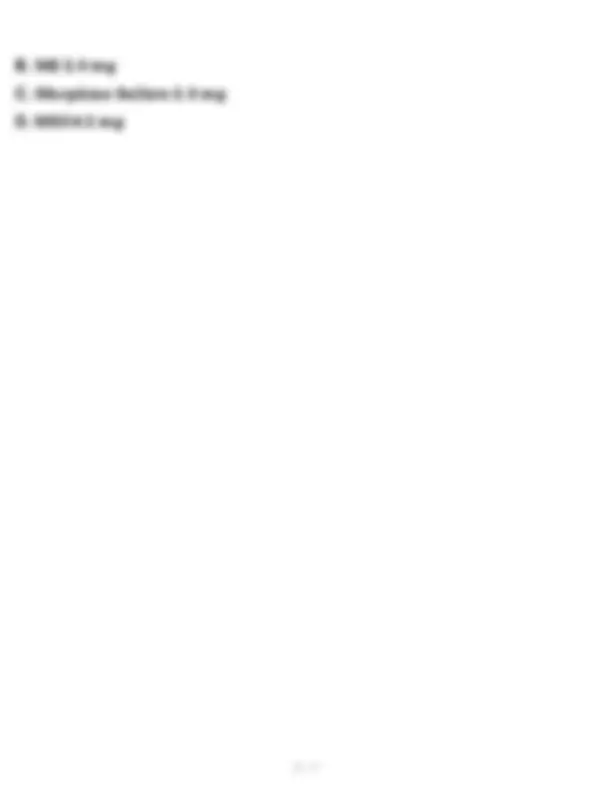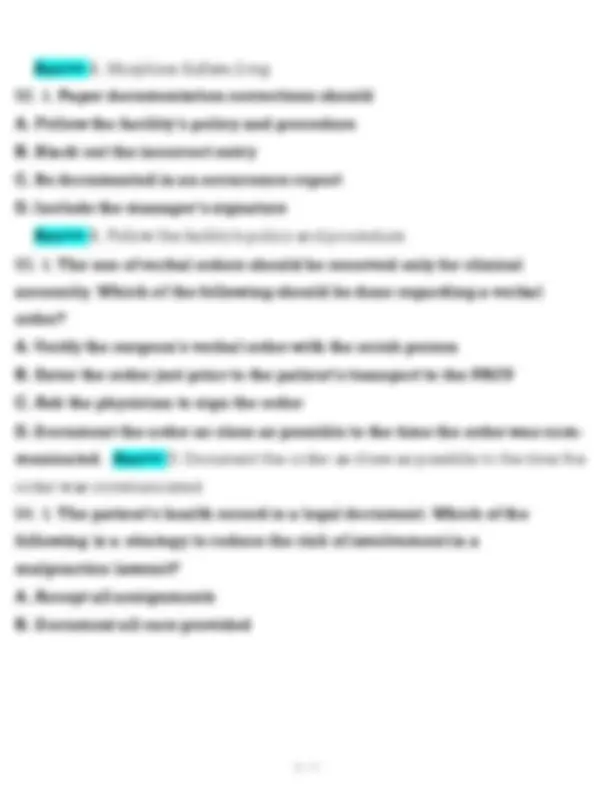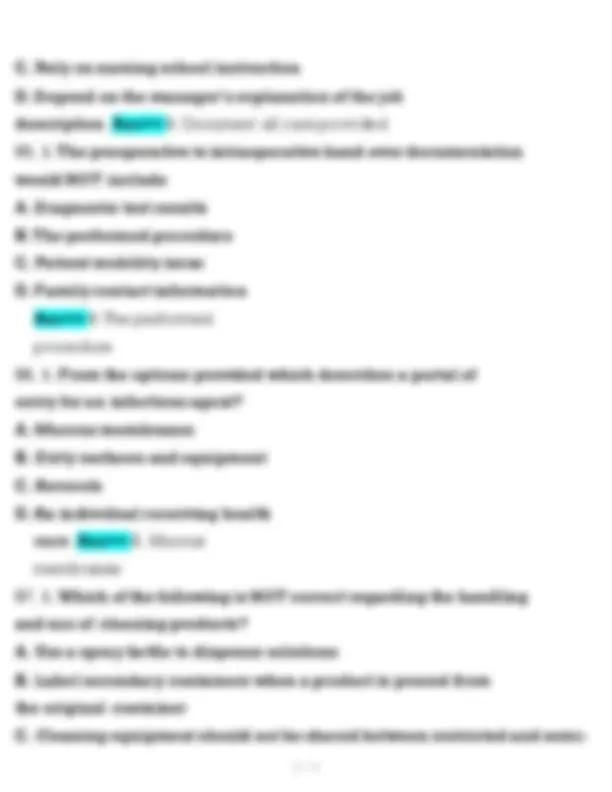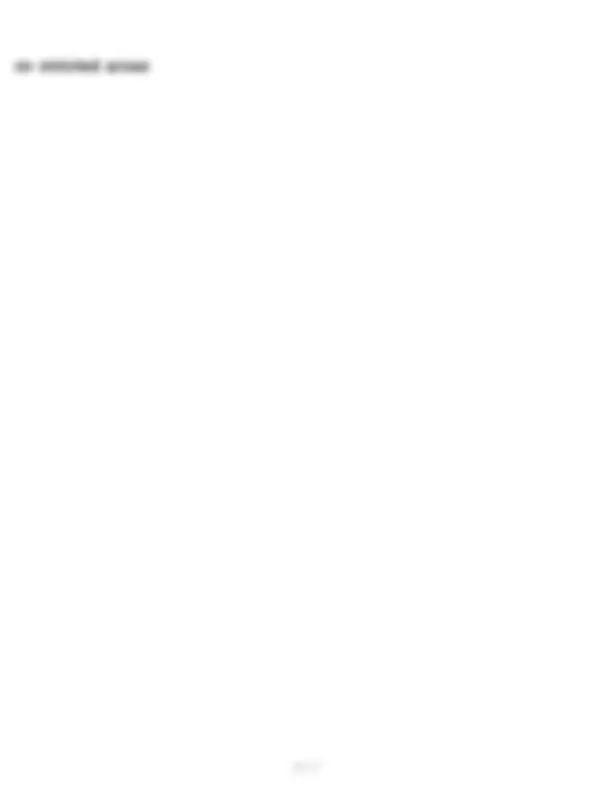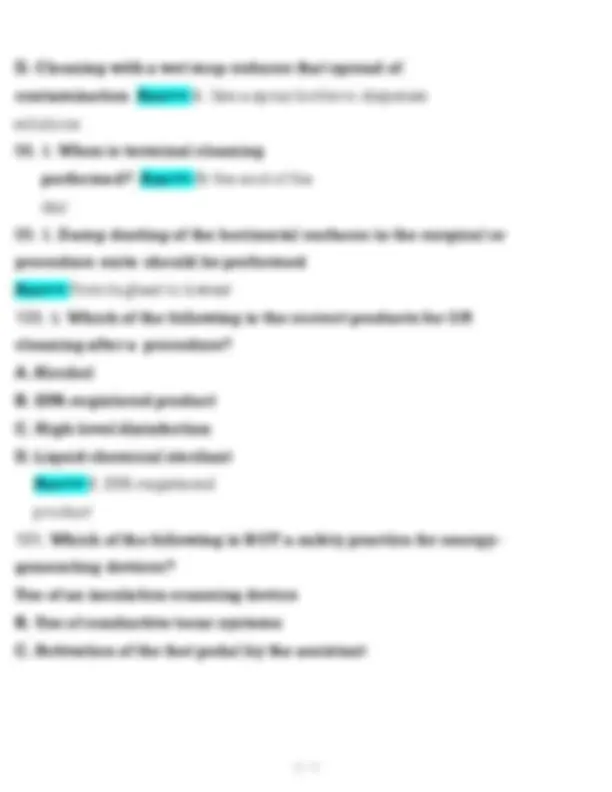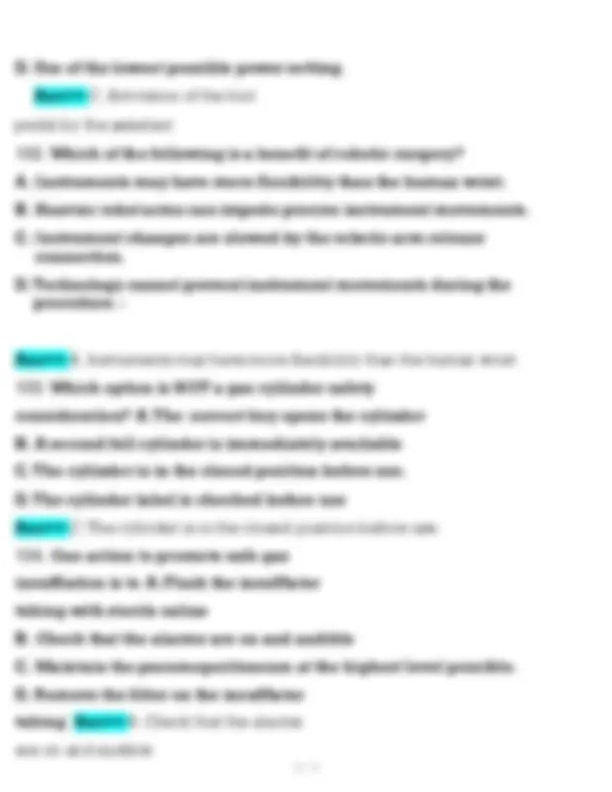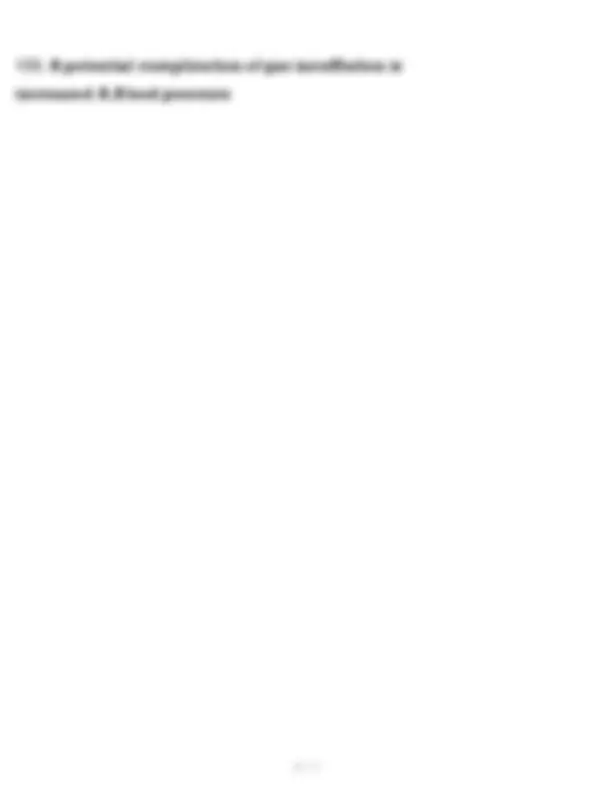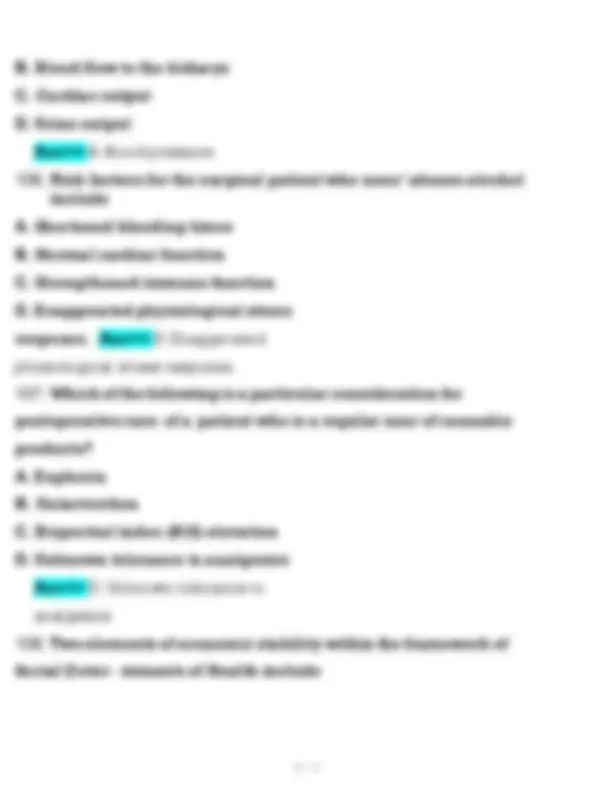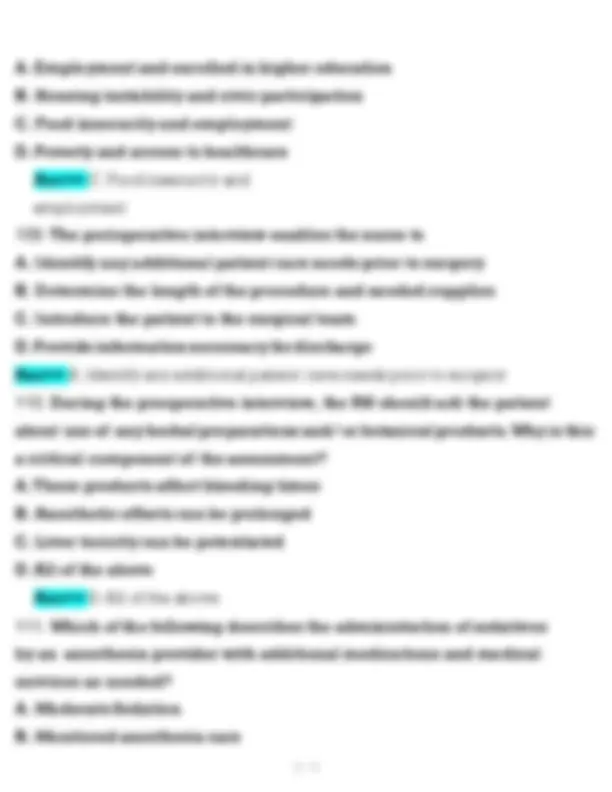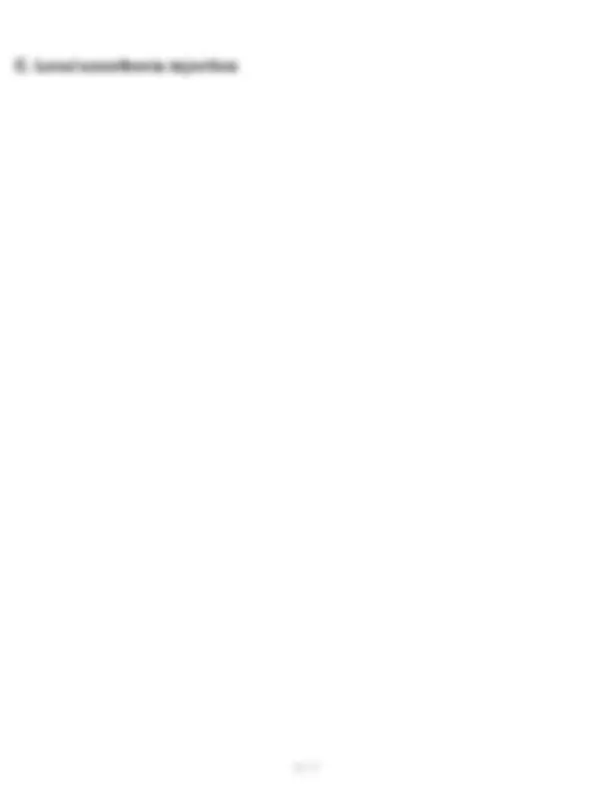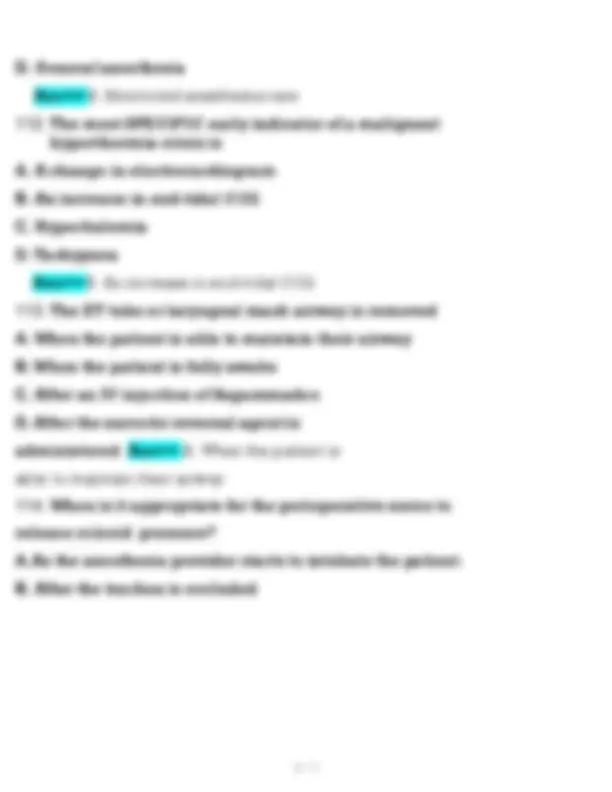Download AORN PERIOP 101 FINAL EXAM Questions and Answers (Verified Revised Full Exam) and more Exams Nursing in PDF only on Docsity!
AORN PERIOP 101 FINAL EXAM
Questions and Answers (Verified Revised
Full Exam)
- There are three types of wound healing. Choose the option that describes secondary intention. A. The wound is approximated with no wound separation. B. The wound is cleaned, debriefed and packed. C. The wound is vascularized. D. Delayed healing may result in weak tissue approximation and herniation Ans>> D. Delayed healing may result in weak tissue approximation and herniation
- An example of a simple drain is Ans>> Penrose drain
- Which statement is an accurate description of negative
pressure wound therapy? A. Applies constant, positive wound pressure. B. Promotes wound contracture.
A. Elective surgery is postponed until test confirm that the patient is not infectious. B. Room access is restricted until 95% of airborne particles have been filtered. C. A multi-use bacterial filter is used on either the breathing circuit or endo- tracheal tube. D. The Center for Disease Control and Prevention and the AORN endorse the use of powered air-purifying respirators during surgical procedures. Ans>> A. Elective surgery is postponed until test confirm that the patient is not infectious.
- 1. Which statement is included in the Occupational Safety and Health Ad- ministration' Bloodborne Pathogeon's Standards? A. Food is permissible in restricted areas or semi-restricted areas.
B. Personnel working in restricted and semi-restricted areas should apply lip balm to avoid cracked lips. C. Personnel should wash their hands with soap after direct contact with blood, bodily fluids or other potentially infectious materials. D. Education on occupational exposure should be provided to healthcare personnel ever 2 years. Ans>> C. Personnel should wash their hands with soap after direct contact with blood, bodily fluids or other potentially infectious materials.
- Choose the option that describes the personal protective equipment (PPE) necessary for healthcare personnel transporting a patient that requires con- tact precautions A. PPE is required for all team members for each patient transport. B. PPE is not required for patient transport. C. PPE is required for all team members when patient transport is necessary. D. PPE is required for designated team member when direct contact is neces- sary. Ans>> B. PPE is not required for patient transport.
- 1. Choose the term that describes the amount of the virus that is found in the individual's blood. A. Viral shedding. B. Viral load. C. Viral
Ans>> B. Viral load
- 1. Which element of the chain of infection describes a microorganism after exiting an infectious reservoir? A. Mode of transmission. B. Susceptible host. C. Portal of entry. D. Infectious agent. Ans>> A. Mode of transmission
- 1. Which gowning and gloving action would a scrub nurse preform? A. Changing gloves every 90-150 minutes or after contact with bone cement. B. Drying arms and hands by waving them in the air. C. Gloving after team members only when the hand is exposed and the sterile gown cuff is at the wrist. D. Wearing double gloves that are extra loose to avoid numbness. Ans>> A. Changing gloves every 90 - 150 minutes or after contact with bone cement.
- 1. Which barrier level gown would you choose if you anticipated high risk of exposure? A. Level 1 B. Level 2
C. Level 3 D. Level 4 Ans>> D. Level 4
- 1. Which of the following statements regarding surgical attire is COR- RECT? A. Personnel don a head covering before entering unrestricted areas. B. Masks are required in semi-restricted areas. C. Personnel remove all hand and wrist jewelry before preforming hand hy- giene. D. Beard covers are only required in restricted areas. Ans>> C. Personnel remove all hand and wrist jewelry before preforming hand hygiene.
- 1. Which of the following statements regarding hand hygiene is INCOR- RECT? A. Fingernails should be kept short and clean. B. Personnel should follow the facility's policy and procedure regarding the use of nail polish. C. Hand hygiene is the single most effective infection prevention action. D. Personnel should use personal hand lotion to maintain their skin integrity.-
Ans>> D. Personnel should use personal hand lotion to maintain their skin integrity.
- 1. Knowing instrument names helps with
D. None of the above. Ans>> A. The count process
- Instruments are inspected at multiple points of use during the sterilization process. Which step is the preventative measure? A. Point of use lubrication of a requested instrument. B. Scheduled inspection of instrument sets. C. Use of a cracked insulated instrument on an emergency surgery. D. Use of a misaligned instrument for grasping tough tissue. Ans>> B. Scheduled inspection of instrument sets.
- 1. Which option describes a critical patient safety step that the scrub nurse takes prior to laparoscopic surgery? A. Checks the surface of the insulated instruments for tears and cracks. B. Identifies laparoscopic instruments by looking at the instrument tips. C. Measure the width of laparoscopic instruments. D. Determines the length of each trocar. Ans>> A. Checks the surface of the insulated instruments for tears and cracks.
- 1. Which of the following options concerning minimally invasive surgery that is performed via a robot is NOT correct?
A. Robotic instruments are similar to laparoscopic instruments. B. The robotic arms are part of the surgeon's consul. C. The video cart contains equipment such as the camera monitor and light source. D. The operating surgeon has control of the robotic instrument, camera and scope. Ans>> B. The robotic arms are part of the surgeon's consul.
- 1. A consideration that would NOT be considered in instrument assembly is A. A patient population. B. Type of surgery. C. Tray weights. D. Scheduling conflicts. Ans>> D. Scheduling conflicts.
- 1. Which of the following sterile towels is considered a drape? A. Disposable cloth towels. B. Reusable cloth towels. C. Skin prep towel. D. Impervious towel. Ans>> D. Impervious towel.
- 1. Before a central venous catheter insertion, the provider should A. Use an area specific plastic drape.
D. Wipe the area with an alcohol wipe. Ans>> C. Don sterile gown and gloves.
- 1. Which statement about draping the sterile field is INCORRECT? A. Scrubbed personnel remove and replace their gloves after draping. B. There is an increased risk for contamination of the sterile personnel's gown and gloves when dropping the sterile field. C. The unscrubbed team member last apply the sterile drapes to create a sterile field. D. The draping process is carefully monitored by all team members. Ans>> C. The unscrubbed team member last apply the sterile drapes to create a sterile field.
- 1. The purpose of the surgical drape is to A. Reduce the risk of hospital acquired infections. B. Cover furniture for use by non-sterile personnel. C. Allow the passage microbes between unsterile and sterile areas. D. Provide a two sided sterile barrier. Ans>> A. Reduce the risk of hospital acquired infections.
- 1. Which of the following is a traffic rule that the scrub person should observe? A. Turn their back to the sterile field to get an instrument.
B. Maintain a distance from the sterile field. C. Cross arms and put their hands in their axilla to keep sterile. D. Change position with another scrub person either face- to-face or back-to-back. Ans>> D. Change position with another scrub person either face-to-face or back-to-back.
- 1. A principle of covering or uncovering a sterile field includes A. Covering multiple sterile fields to allow for quick turnovers. B. Covering a portion of the sterile field until needed. C. Covering a sterile field with one uncuffed drape. D. Remove a cover by lifting drape from below the sterile field. Ans>> B. Covering a portion of the sterile field until needed.
- 1. A factor that would negatively affect the sterility of an instrument is A. Regulated humidity and temperature. B. Use of approved packaging materials. C. Exposed to moisture. D. Transported out of the surgical suite with a protective cover. Ans>> C. Exposed to moisture.
- 1. When opening a blue wrapped item, the nurse should A. Inspect the wrap integrity for holes and tears. B. Open the top flap toward their body. C. Allow side flaps to hang loose. D. Open the last flap toward the scrub person. Ans>> A. Inspect the wrap integrity
A. The neck to below the natural waist. B. The chest to the level of the sterile field. C. The shoulder to the proximal edge of the cuff. D. 2 inches above the elbow to the distal edge of the cuff. Ans>> B. The chest to the level of the sterile field.
- 1. Instrument sets MUST not weigh more than Ans>> 25lbs
- 1. Choose the option that does NOT accurately depict concepts of imme- diate use steam sterilization (IUSS). A. An instrument for IUSS should be cleaned in the scrub sink. B. A rigid enclosed container is used for IUSS cycle. C. A biological indicator is run with an implant load. D. Items are not stored for future procedures. Ans>> A. An instrument for IUSS should be cleaned in the scrub sink.
- 1. Which is an accurate statement regarding shelf-life? A. A shelf-life is event related.
B. Shelf-life is time related. C. Shelf-life is not affected by handling. D. Shelf-life is not affected by storage temperature. Ans>> A. A shelf-life is event related.
- 1. Which statement related to biological indicators (BI) testing is true? A. An unprocessed BI vial should produce a positive test after incubation. B. Both BI vials are placed in the sterilizer together. C. A sterilizer quality test is performed at least every six months. D. Any BI type can be used for any sterilization method. Ans>> A. An unprocessed BI vial should produce a positive test after incubation.
- 1. Why is water temperature an important consideration when cleaning instruments? A. Cool water makes it harder to removed soil from the instrument cervices. B. Cool water prevents blood coagulation. C. Hot water makes blood easier to remove. D. Hot water is the preferred temperature for manufactures. Ans>> B. Cool water prevents blood coagulation.
- 1. Personnel establishing the chain of custody for forensic evidence must do all EXCEPT the following? A. Adhere to regulatory requirements for evidence admission into a court of law. B. Detail who collected the specimen and how it was handled.
- 1. Retrieval of bullets and other metal objects for forensic study requires A. Rinsing, washing and wiping the item clean of blood and other bodily fluids. B. Retrieving the item with a metal instrument. C. An open procedure rather than endoscopic procedure. D. Metal instrument tip protective devices. Ans>> D. Metal instrument tip protective devices.
- 1. What action should be taken when transferring a specimen off the sterile field? A. Wait until the end of the case to transfer the specimen into a container. B. Deposit the specimen into the smallest container that can be closed. C. Confirm the type of test that is be requested with the surgeon.
D. Immerse the specimen into preservative until further instruction. Ans>> C.Confirm the type of test that is be requested with the surgeon.
- 1. Which of the following is NOT an appropriate action for specimen han- dling on the sterile field? A. Cover the specimen or place in a sterile specimen container. B. Label the covered or contained specimen. C. Ensure that the specimen stays dry until the transfer off the sterile field. D. Handle the specimen as little as possible. Ans>> C. Ensure that the specimen stays dry until the transfer off the sterile field.
- 1. The specimen transport container should A. Display the patient's information for ease of specimen hand-over. B. Have a biohazard label for fresh or frozen specimens only. C. Be stored in the operating room until the specimen can be transported to the pathology department. D. Protect the integrity of the specimen. Ans>> D. Protect the integrity of the specimen.
- 1. Specimen management errors can result in A. A lower incident of morbidity. B. Potential litigation. C. Increase in community trust. D. Faster diagnostic results. Ans>> B.

